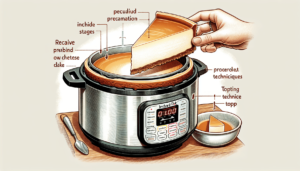The Instant Pot Has Steam Coming Out Is That Normal: Introduction
Being a proud owner of an Instant Pot, we understand the excitement and apprehension that comes with experiencing its steam release feature for the first time. Rest assured, dear reader, that the sight of steam billowing out of your Instant Pot is perfectly normal and, in fact, an essential part of its efficient cooking process. In this article, we will answer your question “The Instant Pot Has Steam Coming Out Is That Normal.” We’ll delve into the reasons behind this steam release, explaining why it is a sign of a well-functioning appliance that promises delectable meals in a fraction of the time.

Overview
Welcome to our comprehensive guide on understanding the steam generation in the Instant Pot! As proud owners of this versatile kitchen appliance, we know how exciting it can be. But sometimes, we may notice steam escaping from our Instant Pot, and we wonder if it’s normal. In this article, we will dive deep into the world of Instant Pot steam, explaining what it is, how it works, and the signs of normal steam release. We will also explore possible causes for excessive steam and provide safety measures, troubleshooting tips, and answers to common FAQs. So, let’s unravel the mystery behind the Instant Pot’s steam and make cooking even more enjoyable!
Understanding the Instant Pot
What is an Instant Pot?
The Instant Pot has revolutionized the way we cook, combining the functionality of multiple kitchen appliances into one. It is an electric pressure cooker that can also be used for slow cooking, sautéing, steaming, yogurt making, and more. With its easy-to-use controls and faster cooking times, the Instant Pot has gained immense popularity among busy individuals and avid home cooks alike.
How does an Instant Pot work?
An Instant Pot works on the principle of harnessing pressure and steam to cook food quickly and efficiently. When you set the cooking time and pressure level, the Instant Pot heats up the liquid inside, creating steam and building pressure. This pressure raises the boiling point of the liquid, allowing the food to cook at a higher temperature. As a result, you can prepare meals in a fraction of the time, preserving flavors, nutrients, and moisture.
Steam Generation in Instant Pot
Why does the Instant Pot produce steam?
Steam generation is a crucial aspect of the Instant Pot’s cooking process. As the liquid heats up, it evaporates and turns into steam. This steam plays a vital role in cooking the food by transferring heat and moisture, ensuring even and thorough cooking. Additionally, steam helps to build pressure, creating a sealed environment that further accelerates the cooking process.
How does the Instant Pot generate steam?
The Instant Pot features a tightly sealed lid with a built-in steam release valve. When the pressure inside the pot increases, the steam is released through this valve. This controlled release of steam helps maintain the desired pressure within the pot, preventing excessive pressure buildup and ensuring efficient cooking. The steam release valve is designed to be adjustable, allowing you to regulate the amount of steam being released during the cooking process.
Signs of Normal Steam Release
Knowing the signs of normal steam release in your Instant Pot can provide reassurance and allow you to monitor the cooking progress effectively. Here are some indicators of normal steam release:
Visible steam during cooking
During the cooking process, you may see steam escaping from the Instant Pot. This is a normal occurrence as the pressure builds and the steam is released through the steam release valve. It’s a good sign that your Instant Pot is working correctly.
Steam coming out from the steam release valve
One of the primary purposes of the steam release valve is to allow steam to escape from the Instant Pot. You might observe steam coming out from this valve, especially during the cooking cycle or when the pressure is being released. This is a normal and expected function of the Instant Pot.
Steam escaping around the lid
Especially when you first start using your Instant Pot, you may notice some steam escaping around the edges of the lid. This can be due to initial adjustments or minor imperfections in the sealing process. However, as long as the steam release valve is working properly, this slight escape of steam should not cause any concerns.

Possible Reasons for Excessive Steam
While a certain amount of visible steam is normal during the Instant Pot’s cooking process, excessive steam may indicate an issue. Several factors can contribute to excessive steam generation, including:
Overfilling the Instant Pot
If you fill the Instant Pot beyond its recommended maximum capacity, it can lead to excessive steam. Overfilling prevents the pot from building and maintaining the necessary pressure required for proper cooking. To avoid this, always follow the manufacturer’s guidelines regarding food and liquid quantities.
Improper sealing of the lid
A properly sealed lid is crucial for the Instant Pot to function optimally. If the lid is not sealed correctly, steam can escape, affecting the pressure buildup and cooking process. Ensure that the sealing ring is clean and correctly positioned, and check that the lid is securely locked in place before cooking.
Blockage in the steam release valve
A blockage in the steam release valve can disrupt the steam release process and prevent proper pressure buildup. Food particles or residue may accumulate in the steam release valve over time, leading to excessive steam generation. Regularly inspect and clean the valve to ensure unrestricted steam release.
Faulty pressure release mechanism
In some cases, a faulty pressure release mechanism can result in excessive steam. If the pressure release valve fails to seal properly or if the float valve is malfunctioning, it can lead to ongoing steam release. If you suspect a mechanical issue with your Instant Pot, contact the manufacturer for assistance.
Safety Measures and Precautions
To ensure safe and efficient use of your Instant Pot, here are some essential safety measures and precautions to keep in mind:
Check the sealing ring regularly
The sealing ring is a vital component for maintaining a proper seal in the Instant Pot. Over time, it may become worn, damaged, or accumulate residue that can affect the sealing performance. Regularly inspect the sealing ring and replace it if necessary to ensure a secure seal.
Ensure proper venting and sealing
Before starting the cooking process, double-check that the steam release valve is in the correct position for pressure cooking, and the lid is securely locked. This will help prevent steam leakage during cooking and maintain the necessary pressure.
Release pressure carefully
When the cooking time is complete, it’s time to release the pressure. Follow the appropriate method for your recipe – quick release or natural release – and release the pressure carefully. Avoid placing your face or hands directly above the steam release valve to prevent any burns from the hot steam.
Avoid overfilling the Instant Pot
As mentioned earlier, overfilling the Instant Pot can lead to excessive steam generation and may compromise the cooking process. To ensure safe and efficient cooking, adhere to the recommended maximum food and liquid levels as specified by the manufacturer.
Clean and maintain the Instant Pot properly
Regular cleaning and maintenance are key to ensuring your Instant Pot functions optimally. Clean the sealing ring, steam release valve, and other components after each use to remove any buildup or debris that may interfere with the steam release and sealing processes.

Common FAQs about Instant Pot Steam
Is it normal for the Instant Pot to release steam when not in use?
It is normal for some residual steam to escape when the Instant Pot is not in use. This occurs as the pot cools down and the pressure naturally releases. However, if you notice continuous or excessive steam release when the Instant Pot is not in use, it may indicate a problem with the sealing or pressure release mechanism.
Why is my Instant Pot not releasing any steam?
If your Instant Pot is not releasing any steam, it may be due to improper sealing or a malfunctioning pressure release mechanism. Ensure that the sealing ring is clean, properly positioned, and intact. Check the steam release valve and float valve for any blockages or mechanical issues. If the problem persists, it is recommended to seek assistance from Instant Pot customer support.
How to reduce steam release during cooking?
To reduce steam release during cooking, you can try adjusting the cooking settings. For recipes that require high pressure, decrease the cooking time slightly to minimize steam generation. Additionally, ensure that the Instant Pot is not overfilled and that the lid is properly sealed. These measures can help regulate steam release and maintain the desired cooking environment.
Troubleshooting Tips for Excessive Steam
If you’re experiencing excessive steam in your Instant Pot, here are some troubleshooting tips to help you identify and address the issue:
Check for proper sealing
Inspect the sealing ring to ensure it is clean, in good condition, and properly positioned. Make sure the lid is securely locked in place. Any gaps or misalignment can cause steam leakage and excessive steam generation.
Inspect the steam release valve
Carefully check the steam release valve for any blockages or obstructions. Clean it thoroughly to remove any food particles or residue that may be hindering steam release. If the valve appears damaged or fails to function correctly, contact Instant Pot customer support for further assistance.
Adjust the cooking settings
If you consistently experience excessive steam during the cooking process, consider adjusting the cooking settings. Decreasing the cooking time slightly or using a lower pressure level can help reduce steam generation. Experiment with different settings to find the balance that works best for your recipes.
Contact Instant Pot customer support
In cases where troubleshooting tips do not resolve the excessive steam issue, it is advisable to contact Instant Pot customer support. They can provide expert guidance, diagnose any underlying problems, and offer solutions tailored to your specific situation.
Conclusion
We hope this comprehensive guide has shed light on the steam generation in your Instant Pot and helped answer any questions you may have had. Understanding the normal signs of steam release, possible causes for excessive steam, and taking necessary safety measures are essential to ensure efficient and safe cooking experiences. Remember to always follow the manufacturer’s guidelines, clean and maintain your Instant Pot, and seek professional assistance when needed. With these tips and knowledge, you can confidently embark on your Instant Pot culinary adventures and enjoy delicious meals prepared in no time!




